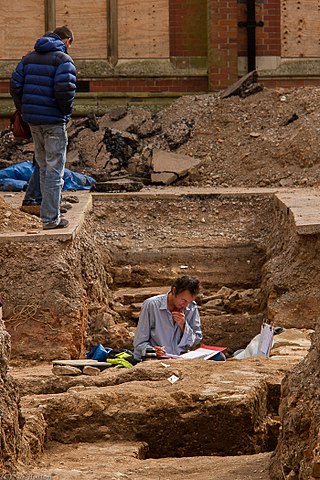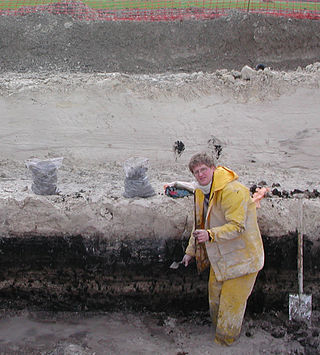Issues of definition
Natural is becoming a blurred term in archaeology due to an increased understanding by researchers of natural processes. In addition, through the development of geoarchaeology, scholars believe the natural landscape has a bearing on interpretation of subsequent human activity on any given site. As geoarchaeology continues to influence the interpretation of processes that occur within the archaeological record, the term "natural" has become less useful. [2]
Natural can be a relative term. On urban sites, where research interests may make a detailed examination of the earliest part of the record impractical, rudimentary human or prehistoric activity may go unrecorded, as opposed to an equivalent horizon on a rural site for which the study team's agenda is to look for prehistoric evidence. Chemical and soil process over time often obscure and cause decomposition of cultural materials, and thus a human-occupied layer may look natural. Additionally, early prehistoric tools were manufactured from natural materials, such as bone, stone and fiber; they do not stand out as clearly as metal, glass and plastic. The effect of decompositional processes is that the older an archaeological deposit is, the more it will appear similar to the underlying geology. For some archaeologists, a basic rule of thumb is "the greater the contrast a context has with the natural, the younger it is." Similarly, United States prehistoric archaeologists often rely on significantly diminished counts of lithic flake debitage to assess the excavation unit's trend toward natural stratigraphy. While a trend may be recognized, a stratum is not called natural or sterile, unless it is void of cultural materials.

In archaeology, excavation is the exposure, processing and recording of archaeological remains. An excavation site or "dig" is the area being studied. These locations range from one to several areas at a time during a project and can be conducted over a few weeks to several years.

An archaeological site is a place in which evidence of past activity is preserved, and which has been, or may be, investigated using the discipline of archaeology and represents a part of the archaeological record. Sites may range from those with few or no remains visible above ground, to buildings and other structures still in use.

In archaeological excavation, a feature is a collection of one or more contexts representing some human non-portable activity, such as a hearth or wall. Features serve as an indication that the area in which they are found has been interfered with in the past, usually by humans.

Urban archaeology is a sub discipline of archaeology specializing in the material past of towns and cities where long-term human habitation has often left a rich record of the past. In modern times, when someone talks about living in a city, they are in an area with many surrounding people and buildings, generally quite tall ones. In archaeological terms, cities give great information because of the infrastructure they have and amounts of people that were around one another. Through the years there has been one big method used for urban archaeology along with significant historic developments.
In the field of archaeology a deposit model is a method of identifying the character and degree of survival of buried archaeological remains over a specified area without necessarily excavating the whole area.

Prehistoric archaeology is a subfield of archaeology, which deals specifically with artefacts, civilisations and other materials from societies that existed before any form of writing system or historical record. Often the field focuses on ages such as the Stone Age, Bronze Age and Iron Age, although it also encompasses periods such as the Neolithic. The study of prehistoric archaeology reflects the cultural concerns of modern society by showing interpretations of time between economic growth and political stability. It is related to other disciplines such as geology, biology, anthropology, historiography and palaeontology, although there are noticeable differences between the subjects they all broadly study to understand; the past, either organic or inorganic or the lives of humans. Prehistoric archaeology is also sometimes termed as anthropological archaeology because of its indirect traces with complex patterns.

Environmental archaeology is a sub-field of archaeology which emerged in 1970s and is the science of reconstructing the relationships between past societies and the environments they lived in. The field represents an archaeological-palaeoecological approach to studying the palaeoenvironment through the methods of human palaeoecology and other geosciences. Reconstructing past environments and past peoples' relationships and interactions with the landscapes they inhabited provide archaeologists with insights into the origins and evolution of anthropogenic environments and human systems. This includes subjects such as including prehistoric lifestyle adaptations to change and economic practices.

Stratigraphy is a key concept to modern archaeological theory and practice. Modern excavation techniques are based on stratigraphic principles. The concept derives from the geological use of the idea that sedimentation takes place according to uniform principles. When archaeological finds are below the surface of the ground, the identification of the context of each find is vital in enabling the archaeologist to draw conclusions about the site and about the nature and date of its occupation. It is the archaeologist's role to attempt to discover what contexts exist and how they came to be created. Archaeological stratification or sequence is the dynamic superimposition of single units of stratigraphy, or contexts.

Geoarchaeology is a multi-disciplinary approach which uses the techniques and subject matter of geography, geology, geophysics and other Earth sciences to examine topics which inform archaeological and chronological knowledge and thought. Geoarchaeologists study the natural physical processes that affect archaeological sites such as geomorphology, the formation of sites through geological processes and the effects on buried sites and artifacts post-deposition.

In archaeology, survey or field survey is a type of field research by which archaeologists search for archaeological sites and collect information about the location, distribution and organization of past human cultures across a large area. Archaeologists conduct surveys to search for particular archaeological sites or kinds of sites, to detect patterns in the distribution of material culture over regions, to make generalizations or test hypotheses about past cultures, and to assess the risks that development projects will have adverse impacts on archaeological heritage.

The Harris matrix is a tool used to depict the temporal succession of archaeological contexts and thus the sequence of depositions and surfaces on a 'dry land' archaeological site, otherwise called a 'stratigraphic sequence'. The matrix reflects the relative position and stratigraphic contacts of observable stratigraphic units, or contexts. It was developed in 1973 in Winchester, England, by Edward C. Harris.
The following outline is provided as an overview of and topical guide to archaeology:
The archaeological record is the body of physical evidence about the past. It is one of the core concepts in archaeology, the academic discipline concerned with documenting and interpreting the archaeological record. Archaeological theory is used to interpret the archaeological record for a better understanding of human cultures. The archaeological record can consist of the earliest ancient findings as well as contemporary artifacts. Human activity has had a large impact on the archaeological record. Destructive human processes, such as agriculture and land development, may damage or destroy potential archaeological sites. Other threats to the archaeological record include natural phenomena and scavenging. Archaeology can be a destructive science for the finite resources of the archaeological record are lost to excavation. Therefore, archaeologists limit the amount of excavation that they do at each site and keep meticulous records of what is found. The archaeological record is the physical record of human prehistory and history, of why ancient civilizations prospered or failed and why those cultures changed and grew. It is the story of the human world.

James M. Adovasio is an American archaeologist and one of the foremost experts in perishable artifacts. He was formerly the Provost, Dean of the Zurn School of Natural Sciences and Mathematics, and Director of the Mercyhurst Archaeological Institute at Mercyhurst University in Erie, Pennsylvania, Adovasio is best known for his work at Meadowcroft Rockshelter in Pennsylvania and for his subsequent role in the "Clovis First" debate. He has published nearly 400 books, monographs, articles, and papers in his field.
In archaeology and paleontology a faunal assemblage is a group of animal fossils found together in a given stratum. In a non-deformed deposition, fossils are organized by stratum following the laws of uniformitarianism and superposition, which state that the natural phenomena observable today also apply to the paleontological record and that the oldest stratum will be at the bottom of a paleontological deposit.

The Modoc Rock Shelter is a rock shelter or overhang located beneath the sandstone bluffs that form the eastern border of the Mississippi River floodplain at which Native American peoples lived for thousands of years. This site is significant for its archaeological evidence of thousands of years of human habitation during the Archaic period in the Eastern United States. It is located on the northeastern side of County Road 7 southeast of Prairie du Rocher in Randolph County, Illinois, United States. It was declared a National Historic Landmark in 1961.

Gatecliff Rockshelter (26NY301) is a major archaeological site in the Great Basin area of the western United States that provides remarkable stratigraphy; it has been called the "deepest archaeological rock shelter in the Americas". Located in Mill Canyon of the Toquima Range in the Monitor Valley of central Nevada, Gatecliff Rockshelter has an elevation of 7,750 feet (2,360 m). David Hurst Thomas discovered Gatecliff Rockshelter in 1970 and began excavations in 1971. Full scale excavations occurred at Gatecliff Rockshelter for about seven field seasons in which nearly 33 feet (10 m) of sediments were exposed for a well-defined stratigraphic sequence. The well-preserved artifacts and undisturbed sediments at Gatecliff Rockshelter provides data and information have been applied to a range of research topics. Based on the analysis of the artifacts at Gatecliff Rockshelter, it can be determined that it was most likely a short-term field camp throughout prehistory. The latest evidence for human usage at Gatecliff occurs between ca. 5500 B.P. to 1250 B.P.

Archaeology or archeology is the study of human activity through the recovery and analysis of material culture. The archaeological record consists of artifacts, architecture, biofacts or ecofacts, sites, and cultural landscapes. Archaeology can be considered both a social science and a branch of the humanities. It is usually considered an independent academic discipline, but may also be classified as part of anthropology, history or geography.
The soil biomantle can be described and defined in several ways. Most simply, the soil biomantle is the organic-rich bioturbated upper part of the soil, including the topsoil where most biota live, reproduce, die, and become assimilated. The biomantle is thus the upper zone of soil that is predominantly a product of organic activity and the area where bioturbation is a dominant process.
Cultural layer is a key concept in archaeology, particularly culture-historical archaeology especially in archaeological digs or excavations. A cultural layer helps determine an archaeological culture: the remnants of human settlement that can be grouped and identified as coming from approximately the same distinct time period.













